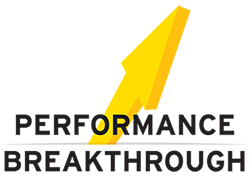STRIVING. PERFORMING. ACHIEVING. Those three words say a lot. When you STRIVE, you work hard and exert yourself, often against the tide of conventional opinion, competition, and your own complacency, doubts and fears. When you PERFORM, you are using your skills and abilities to do something…to execute and to get results. Ultimately, when you ACHIEVE, you are living a purposeful life. You reach a level of performance that is indicative of true success: you’re achieving your goals and dreams!
We understand that success is a journey and a way of living purposefully, not a destination. The foundation of our business coaching work is represented by The Formula for Success:
A ( S + K ) + G = PBC IR (O, P)
Attitudes plus Skills & Knowledge directed by Goals delivers Positive Behavior Change which yields Improved Results, both Organizationally and Personally.
Let’s look at each component of the Formula, working from right to left…
IR
The first thing we look for is how our clients define success. We start out by asking what improved results (IR) our clients want to achieve in their organization or in their personal lives, and how that will be tracked and measured. The importance of a thoughtful definition of success is that it provides a target toward which everyone can aim. Everything else we do is specifically geared around achieving those results.
PBC
Wouldn’t you agree that if that target is different than where you are today, then you must do something (behave) differently to get there? PBC represents positive behavior change. A definition of insanity is doing the things you’ve always done, but expecting different outcomes.
G
G represents goals. Goals provide focus, otherwise there is no direction. Doesn’t it make sense that if people had goals on which to focus their energy, it would be easier to change their behavior in a way that can be sustained? Goal setting is the tool that generates the activity necessary to turn ideas into strategy, strategy into plans, and plans into reality.
S+K
S+K represent the necessary skills (the how to do something) and knowledge (the where and when to do something). Our process focuses on development of behavioral management skills, meaningful communications, influencing or selling skills, problem solving, decision making, organizing time, disciplining, developing subordinates, delegating authority, motivating others, appraising performance, etc. Everyone needs to be very competent in these areas, but especially in the workplace, where more than 50% of any manager’s job involves using these skills.
A
The A stands for attitude (the want to). Our coaching approach is based on a result-oriented philosophy that first involves developing a goal-oriented attitude among people. Attitude is more of a multiplier of skills and knowledge that will directly influence the goals they set and achieve. People will directly determine in many cases whether they turn a problem into an opportunity, or succumb to it; whether they behave in ways that benefit the entire organization or maintain fiefdoms; whether they expand the client base and services provided or allow atrophy to set in; and whether they diligently look for continuous improvement, or remain satisfied with the status quo.
The results we get depend upon our behavior and attitudes toward the people or events involved, and toward ourselves. If attitudes are basically negative, goals will be set low, and it will be difficult to progress. Growth and promotion will be all but impossible until a positive mindset is developed.
There are many ways and opportunities for individuals and organizations to better focus on results, attitudes and behaviors, skills and knowledge, goal setting and achievement. If you are interested in taking an important first step, let’s chat.


